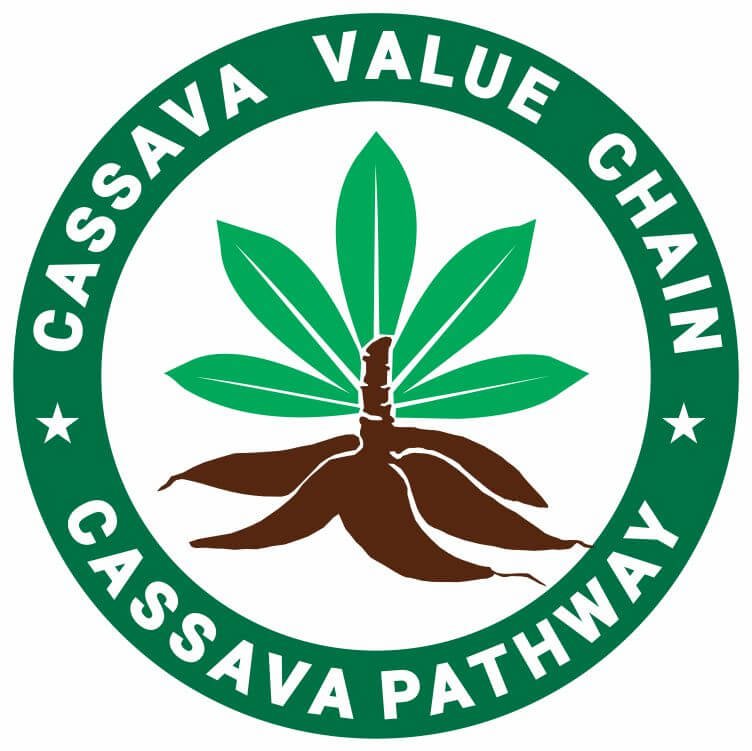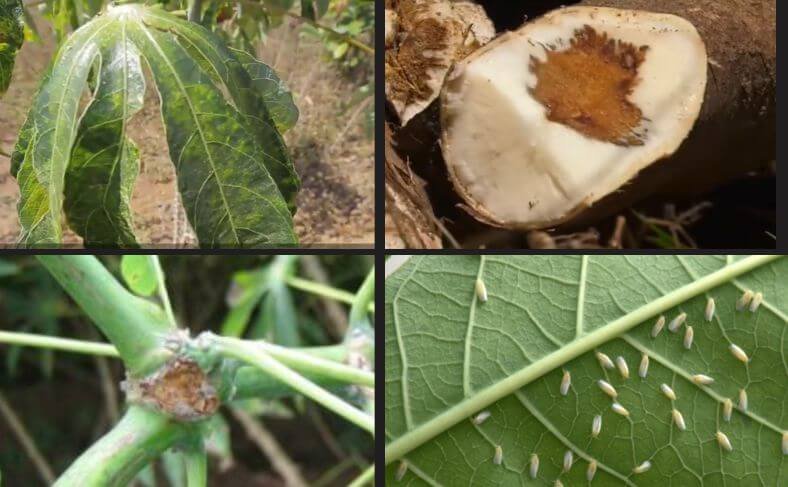Learn about these devastating cassava pests and diseases that reduce cassava yield and practical methods to prevent and control them.
The cassava crop is susceptible to various pests and diseases that can plummet harvests if left unchecked and negatively impact the cassava value chain.
Farmers across tropical regions battle common challenges such as cassava mosaic disease, bacterial blight, and mealybugs, each capable of wiping out entire crops if left unmanaged.
These infestations not only threaten food security but also impact livelihoods and local economies that depend on cassava production.
Understanding these pests and diseases, their causes, and preventive measures is essential for maintaining healthy, productive fields.
From resistant varieties to proper field management and biological controls, prevention is key to sustainable cultivation.
Table of Contents
- What are Cassava Pests and Diseases?
- Cassava Green Spider Mite
- Cassava Mealybug
- Cassava Hornworm Moth
- Cassava Whiteflies
- Cassava Bacterial Blight
- Cassava Brown Streak Virus Disease (CBSD)
- Cassava Mosaic Disease (CMD)
- Cassava Anthracnose Disease (CAD)
- Impact of Pests and Diseases on Cassava Production
- Impacts of Cassava Pests and Diseases on the Cassava Value Chain
- Frequently Asked Questions
- Final Word from Cassava Pathway
What are Cassava Pests and Diseases?
Cassava pests and diseases are biotic factors that attack the cassava plant at various growth stages, from the leaves and stems to the roots, causing damage, yield losses, and economic damage to farmers.
These pests and diseases include insects, mites, viruses, bacteria, and fungi.
Pests like cassava green mites, mealybugs, and whiteflies feed on the plant. In contrast, cassava mosaic disease and brown streak disease cause leaf distortion, stunted growth, and root necrosis.
Let’s take a closer look at some of the cassava pests and diseases, starting with the pests:
Related: What is the Cassava Value Chain
Table of Contents
- What are Cassava Pests and Diseases?
- Cassava Green Spider Mite
- Cassava Mealybug
- Cassava Hornworm Moth
- Cassava Whiteflies
- Cassava Bacterial Blight
- Cassava Brown Streak Virus Disease (CBSD)
- Cassava Mosaic Disease (CMD)
- Cassava Anthracnose Disease (CAD)
- Impact of Pests and Diseases on Cassava Production
- Impacts of Cassava Pests and Diseases on the Cassava Value Chain
- Frequently Asked Questions
- Final Word from Cassava Pathway
Cassava Green Spider Mite

The cassava green spider mite, Mononychellus tanajoa, is one of the pests that is capable of ruining a cassava farm and causing damage that can stifle growth and yield.
How the Cassava Green Mite Operates
The spider mites feed on the underside of fresh leaves, stems, and auxiliary buds of cassava plants with their mouthparts that is designed to pierce and suck.
They pierce into the plant cells, sucking up plant nutrients, including chlorophyll, starving the cassava plant of nutrients.
The Effect of the Cassava Green Mite
This feeding behaviour leaves minute yellowish or orange spots on the leaves.
When many leaves on a particular plant are affected, the plant becomes stunted, mottled, sheds, and dies.
When the green spider mite attacks the terminal shoots, the candlestick symptom happens, where the tips of the plumule or shoots rot and die.
Cassava plants within 3 and 8 months are susceptible to this pest.
When the green mite’s attack is severe, it can cause about 30-80% damage to a cassava farm, causing poor yields.
Also, the quality of the stems is affected, causing a shortage of cassava stem cuttings in the next farming season.
How the Cassava Green Spider Mite Spreads
The cassava green spider mite can spread from one plant and from one farm to another through natural dispersion, like wind, water splashes, or by humans.
The main carriers of the green spider mite are the farmers through the movement of infested cassava stems and cuttings from one farm to another.
Prevention and Control
An integrated strategy is best to manage and control the green spider mite infestation of a cassava farm.
Here is a recommended approach:
- Using the biological strategy of predatory agents like predatory mites and fungi, which feed on the green mites.
- Using chemical control strategies like acaricide abamectin to eliminate the mites. But this should be used with caution as it might cause resistance to secondary infestation.
Related Posts
How to Intercrop Cassava with Other Crops
Cassava Stems – Everything to Know
Planting Cassava the Right Way
Introduction to Cassava Farming
When Should I Harvest My Cassava?
Preparing the Soil and How to Plant Cassava
Cassava Weed Management Strategies
Cassava Farming and the Environment
How to Start Commercial Farming of Cassava
Cassava Mealybug
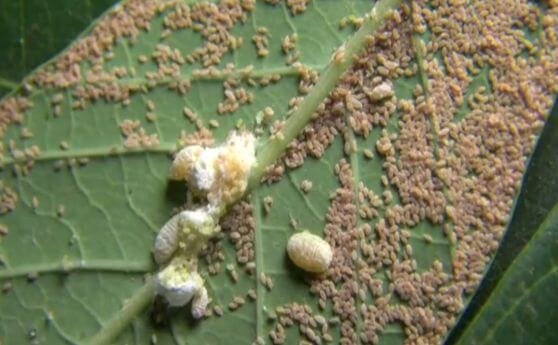
The cassava mealybug, also called Phenacoccus manihoti, is a velvety insect with a segmented body that infests cassava farms, causing serious damage to the value chain of the plant.
Let’s take a closer look at how it operates:
How it Operates
The cassava mealybugs, of course, feed on the leaves, boring into the stems, and growing plumules of cassava plants.
As the mealybugs feed, they suck away at the tissues of the plant, extracting the sap, which is a conveyor of the plant’s nutrients.
The damages the activities of the mealybug cause are as follows:
Damage Caused by Mealybug to Cassava Farms
This feeding activity causes a lot of damaging symptoms, including the following:
- Yellow leaves, curls, and distortions
- Stunted growths and shortened internodes
- Rotting and leaves defoliation
- Weakening of the leaves and withering
- Dieback of the growing shoots
A high mealybug infestation can cause a complete withering of the cassava plant, affecting the stems and cuttings so they are useless for the next planting season.
The cassava mealybug is from South America but was imported to Africa in the 1970s, where it caused yield losses of up to 80% in some regions.
The pest also has spread to Asia, including Thailand, where it has caused yield losses of up to 50%.
Prevention and Control
Effective prevention and control of the cassava mealybug requires an integrated strategy, including the use of:
- Biological control strategy with agents like the parasitoid wasp Anagyrus lopezi can be of health benefit.
- Use of cultural practices, like the use of clean planting material and timely planting.
- Use of chemical control with selective insecticides may also be useful in severe infestation, but should be used cautiously to avoid disrupting the natural enemy populations.
Cassava Hornworm Moth
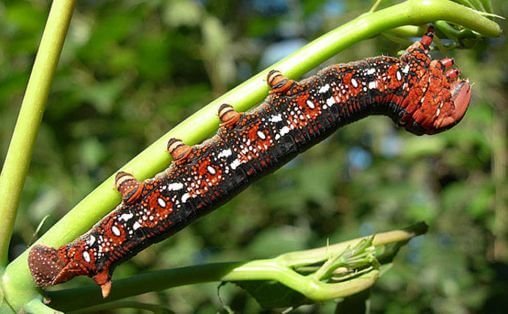
The cassava hornworm, also called Erinnyis ello, is the larva of the hornworm moth that lays its eggs and hatches in about 5 days.
The larva, which is a ferocious feeder, feeds on the leaves and tender shoots of cassava, causing major damage to cassava farms, and affecting the cassava value chain.
Mode of Operation of the Cassava Hornworm on Cassava Farms
As the hornworm larvae feed, they can strip away the foliage, leaving the plant completely withered and defoliated.
In severe infestations, the larvae can destroy an entire cassava crop.
The hornworm larvae feed for 3-4 weeks until they mature, consuming young leaves and growing shoots during this time.
Hornworm Damages to Cassava Farms
Their voracious appetite can lead to total plant defoliation, which not only impacts the current crop but also strips the farmer of quality planting material for the next farming cycle.
This complete withering of leaves reduces the plant’s ability to photosynthesize, leading to stunted growth, reduced root production, and poor root quality.
Severe hornworm attacks can result in bulk root loss and poor root quality, reducing cassava yields.
The degree of damage is affected by the plant’s age, with younger plants more susceptible to complete defoliation.
How to Control and Prevent the Hornworm Cassava Pest
To manage cassava hornworms, the following strategy is advised:
- Hand-picking and destroying the larvae
- Use of biological control agents like parasitoid wasps
- Chemical insecticides should be used in the case of severe infestation, but with caution.
Cassava Whiteflies

Cassava whiteflies are triangular moth-like pests that attack cassava farms, bringing with them destruction, causing poor yields of cassava which can occur by feeding directly on the plant and also transmission of diseases.
How the Cassava Whiteflies Operate
These cassava whitefly insects attack the cassava plant by feeding on the phloem sap of cassava, destroying nutrients and stunting growth.
Here are some of its mechanics:
Direct Feeding on the cassava plant’s phloem: Direct feeding damages causes chlorotic mottling, twisting, and curling of leaves, particularly on the upper leaves. This reduces the plant’s overall health and can cause yield losses of up to 50%.
Excretion of Honeydew: Whiteflies excrete honeydew, which causes the growth of sooty mold fungi on leaves. The sooty mold interferes with photosynthesis, shutting out light and killing the cassava.
Impact of Whiteflies on Cassava Farm
Reduced Growth and Yield: When whiteflies feed on the sap of cassava plants, they can reduce the plant’s ability to take up nutrients and water from the soil. This can result in stunted growth and lower yields for farmers.
Transmission of Diseases: Whiteflies can also transmit diseases to cassava plants, such as cassava mosaic disease and cassava brown streak disease.
Impact of Honeydew: The honeydew produced by whiteflies as they feed attracts other pests, such as ants, which can further jeopardize the plant’s health.
Prevention and Control of Cassava Whiteflies
The cassava whitefly pest can be controlled in the following ways:
- Planting cassava with other crops in a method called intercropping it can reduce whitefly populations
- Regularly identifying whiteflies and using selective insecticides when thresholds are exceeded
- Using whiteflies’ natural enemies, like parasitoid wasps, to biologically control
- Planting virus-free cassava cuttings and using resistant varieties to limit disease transmission
Now let’s look at cassava diseases, their causes, impacts, and how to prevent and control them:
Cassava Bacterial Blight

Description and Characteristics
Cassava bacterial blight (CBB) caused by manihotis, causes the largest damage to cassava yield across the world.
How Cassava Bacterial Blight Operates
The CBB pathogen primarily infects the leaves, stems, and roots of cassava plants.
The cassava bacterial blight operates by causing lesions on the cassava leaves, which form a mass along the veins of the leaves, strangulating it.
Symptoms of Cassava Bacterial Blight
The first visible symptom of CBB includes:
- The infected stems and petioles also rot, showing black of brown bands.
- As the disease gathers momentum, the infected stems and petioles excrete an orange-colored substance, with the leaves withering and shedding, leading to dieback symptoms with naked, leafless stems.
- Dark leaves, water-soaked areas are limited by the leaf veins, which also show sappy excretions.
Spread of Cassava Bacterial Blight
The main means of spreading the CBB disease over long distances is by mistakenly moving infected planting material of cassava from one infected farm to another.
The pathogen causing the disease is capable of in the tissue of a plant for a long time because at that stage, it causes no identifiable symptoms.
The disease can spread from plant to plant through rain, contamination of farm tools, and other insects.
Impact on the Cassava Value Chain
The impacts of CBB can be devastating at every stage of the cassava value chain.
It can cause yield losses of about 40% to 100%, depending on the type of cassava, strain of bacteria, and environmental conditions.
In the past, cassava bacterial blight has resulted in total crop failures in some regions, causing food shortages and malnutrition.
CBB can also affect the quality of cassava, including its availability for processing and marketing along the value chain of cassava.
The discoloration of infected roots and stems reduces their value in the market.
Also, causing further loss in the cassava value chain is the immediate onset of deterioration of the roots after harvest.
Prevention and Control Measures
To prevent and control cassava bacterial blight, the following measures are recommended:
- Use clean, disease-free planting material
- Collect cuttings only from healthy plants and the most lignified portion of the stem
- Disinfect tools regularly
- Plant cassava with other crops like maize or melon to reduce disease incidence
- Apply rotation of crops and allow the land to fallow for at least one rainy season
- Isolate, remove, and destroy all infected plant parts in the farm and surrounding weeds
Cassava Brown Streak Virus Disease (CBSD)
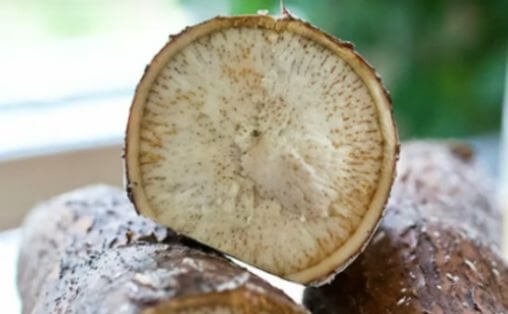
The cassava brown streak virus disease (CBSD) poses a threat to cassava production, with devastating impacts on the entire cassava value chain.
With special attack in East Africa, it was discovered in 1036 in Tanzania and its attack has been recorded in Mozambique and Kenya.
CBSD is caused by two virus species – the cassava brown streak virus (CBSV) and the Ugandan cassava brown streak virus (UCBSV).
The two viruses belong to the genus Ipomovirus in the family Potyviridae.
How Cassava Brown Streak Disease Operates
The cassava brown streak viruses infect the leaves, stems, and roots of cassava plants, boring through the vascular system, disrupting water flow, setting off the characteristic disease symptoms.
Symptoms of Cassava Brown Streak Disease
The most common symptoms of the cassava brown streak disease include:
- Leaf Rot and Chlorosis: The leaves show a mottled, yellow appearance, with the chlorosis often associated with the leaf veins.
- Stem Bruises/Lesions: Brown or black streaks are seen on the stems, and sometimes can extend into the leaf petioles.
- Root Rot: Infected roots show dry, hard rot, making them not eligible for eating.
Spread of Cassava Brown Streak Disease
Once introduced into a new farmland, cassava brown streak disease can quickly spread a cassava-production region, causing serious yielding issues and plummeting food security.
CBSD can spread through the following means:
Infected Planting Material: The main avenue for long-distance spread is through infected cassava cuttings for planting.
Insect vectors: Whiteflies (Bemisia tabaci) can transmit the disease from attacked plants to healthy plants.
Mechanical Transmission: Spreading through farm tools used on infected plants.
Impact on the Cassava Value Chain

The impacts of cassava brown streak disease can be felt at every stage of the cassava value chain:
- Production: Cassava brown streak disease can diminish yields up to 20% to 100%. This is though, depending on the variety and environmental conditions.
- Cassava Cuttings: CBSD-infested planting materials can affect the quality and quantity of clean, healthy cassava cuttings for the next farming cycle.
- Processing and Marketing: If roots are infected, they show streaks of discoloration and signs of rot, which reduces their market and processing value.
Prevention and Control
The prevention and control of the cassava brown streak disease
- Use of clean, virus-free planting material
- Use CBSD-resistant or tolerant cassava varieties
- Prevent the spread of the disease by strict quarantine measures
- Destruction of infected cassava plants
- Use of biological control of natural enemies including parasitoid wasps
- Careful use of chemical pesticides to control insect vectors
Cassava Mosaic Disease (CMD)
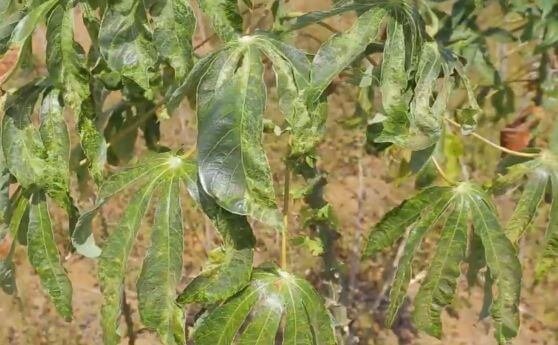
The cassava mosaic disease (CMD) is a threat to cassava production in cassava-producing regions around the world.
Description and Characteristics
CMD is caused by a group of closely related geminiviruses, including the African cassava mosaic virus (ACMV) and the East African cassava mosaic virus (EACMV).
These viruses belong to the genus Begomovirus and infect the leaves, stems, and roots of cassava plants.
Symptoms of the Cassava Mosaic Disease
The effect of the virus on the cassava plant and symptoms can vary depending on the variety of the cassava, virus strain, and other factors.
The most common symptoms of cassava mosaic disease are:
- Yellow, green, or white patches of mosaic patterns appear on the leaves
- Twisting and distortion of leaf sizes
- Stifled growth and poor root development
Transmission
These viruses are transmitted by the whitefly vector, Bemisia tabaci, as well as through the use of infected cassava planting material.
It can also be spread by insects, mites, aphids, fungi and contact.
Impact on Cassava Farms and Value Chain
CMD can have a serious damage on cassava production. Damage can affect yields up to 15-24%, which is equvalent to 12-23 million tonnes per year, having a value of around US$1.2-2.3 billion.
Prevention and Control of Cassava Mosaic Disease
- Use of CMD-resistant or tolerant cassava varieties
- Strict quarantine measures to prevent the introduction and spread of the disease
- Isolation and elimination of infected plants
- Use of natural enemies of the whitefly and other causative agents
- Use of insecticides to eliminate causative agents.
Cassava Anthracnose Disease (CAD)

Cassava anthracnose disease (CAD) is a serious fungal disease that affects cassava crops worldwide, causing the production of cassava to plummet and affecting the cassava value chain.
Description and Characteristics
Cassava anthracnose disease is caused by the fungus colletotrichum gloeosporioides f. sp. manihotis.
This fungus infects the leaves, stems, and roots of cassava plants by.
Symptoms of Cassava Anthracnose Disease
The most prominent symptoms of cassava anthracnose disease include:
- Circular, imploded, bruises on the stems and petioles in the form of lesions with dark color
- Leaves gradually become yellowish and wither
- Death of tender shoots and dieback stems
- Root rot
Transmission of CAD
Cassava anthracnose disease (CAD) can survive on infected plant debris and in the soil.
It is mostly spread through the use of infected planting material, as well as by wind, rain, and insects.
Impact on Cassava Farms and Value Chain
CAD can have a damaging impact on cassava production. Yield losses can range from 20% to 80%, depending on the stage of growth when infection occurs and the strain of the disease.
In extreme infestation, the disease can decimate an entire cassava farm.
The disease can also impact the quality and availability of cassava along the cassava value chain – processing and marketing.
Prevention and Control Measures
Effective management of cassava anthracnose disease requires the following approach:
- Use of disease-resistant varieties of cassava.
- Isolation to halt the spread
- Removing infected plants
- Rotation of crops and applying the fallow technique
- Use of fungicides to control the disease, if necessary
Impact of Pests and Diseases on Cassava Production
The cassava pests and diseases, of course, affect cassava production negatively and also have a crippling effect on the cassava value chain.
Let’s take a look:
The major impacts of cassava pests and diseases on farming and production of cassava are:
1. Severe Yield Losses
Cassava diseases like Cassava Mosaic Disease (CMD) and Cassava Brown Streak Disease (CBSD) can cause yield losses ranging from 20-90%.
These viral diseases, transmitted by whiteflies, can reduce yields by 40-70% for CMD and up to 100% for CBSD.
2. Reduced Tuber Size and Quality
The pests and diseases can lead to stunted plant growth, smaller tubers, and lower-quality cassava roots.
3. Increased Susceptibility to Other Stresses
The impacts of pests and diseases make cassava plants more vulnerable to other environmental and biological stresses.
4. Significant Economic Losses for Farmers
The severe yield reductions and quality impacts translate to major economic losses for smallholder cassava farmers, who rely on the crop as a staple food and income source.
Impacts of Cassava Pests and Diseases on the Cassava Value Chain
Pests and diseases have a significant impact on cassava value chains in cassava-producing regions, leading to substantial yield losses and economic consequences.
Cassava mosaic disease (CMD) and cassava brown streak disease (CBSD) can cause up to 30% of the annual cassava harvest to be lost, equivalent to $1.25 billion worth of production.
CBSD alone is estimated to cause $100 million in economic losses annually. Other challenges include the need to increase yield and manage pests and diseases.
Cassava bacterial blight (CBB) caused major yield losses in the 1970s, though less research is available on its current impact.
Postharvest physiological deterioration (PPD) is another major source of cassava waste and economic losses, especially in areas with less developed transportation networks.
Despite the introduction of improved and resistant cassava varieties, pests and diseases remain a challenge for many smallholder farmers.
Frequently Asked Questions
How do you control the disease in cassava?
To control cassava diseases, use resistant/tolerant varieties, disease-free planting material, and integrated pest management practices.
What is the best pesticide for cassava?
There is no single best pesticide for cassava – an integrated approach using cultural, biological, and limited chemical controls is recommended.
What are two pests of cassava?
Two major pests of cassava are the cassava green mite and cassava mealybug.
Which pest feeds on cassava?
The cassava green mite and cassava mealybug are the main pests that feed on cassava plants.
Final Word from Cassava Pathway
Cassava is a vital staple crop in many regions, but it faces numerous pests and diseases that can devastate production.
From the cassava green mite and mealybug to bacterial blight, mosaic disease, and anthracnose, these pests and diseases pose significant challenges.
However, a well-thought-out approach combining resistant varieties, clean planting material, biological control, and cautious use of pesticides can effectively manage cassava pests and diseases.
The collaboration between farmers and scientists with policymakers is a big step in making sure there is sustainability in the cassava value chain.
Citations:
- https://naads.or.ug/cassava-pests-and-disease-control/
- https://www.slideshare.net/ctaspace/cassava-pests-and-disease
- https://plantvillage.psu.edu/topics/cassava-manioc/infos
- https://link.springer.com/article/10.1007/s11103-021-01170-8
- https://plantvillage.psu.edu/topics/cassava-pests-and-diseases_-save-and-grow/infos
- https://www.linkedin.com/pulse/challenges-pests-diseases-cassava-farming-patience-khasoa-bntjf?trk=article-ssr-frontend-pulse_more-articles_related-content-card
- https://infonet-biovision.org/PlantHealth/MinorPests/cassava-green-spider-mite
- https://plantix.net/en/library/plant-diseases/800045/cassava-green-spider-mite/
- https://apps.lucidcentral.org/ppp/text/web_full/entities/cassava_green_mite_438.htm

Chimeremeze Emeh is a writer and researcher passionate about Africa’s most transformative root crop—cassava. Through his work at cassavavaluechain.com, he explores the entire cassava industry, from cultivation and processing to its diverse applications in food, health, and industrial use.
He also writes for palmoilpalm.com, where he shares his extensive experience and deep-rooted knowledge of palm oil, covering red palm oil, palm kernel oil, and refined products. His work there reflects his lifelong connection to agriculture and his commitment to promoting sustainable value chains in Africa.
Driven by curiosity and purpose, Chimeremeze aims to shed light on how cassava continues to empower communities, strengthen food systems, and link traditional farming wisdom with modern innovation.
